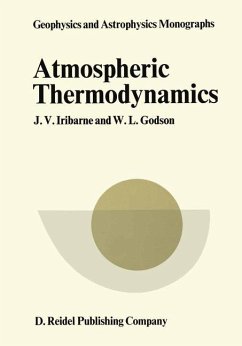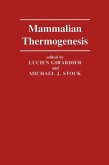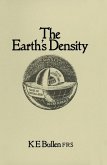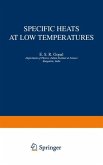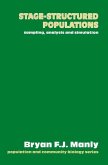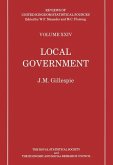- Broschiertes Buch
- Merkliste
- Auf die Merkliste
- Bewerten Bewerten
- Teilen
- Produkt teilen
- Produkterinnerung
- Produkterinnerung
The thermodynamics of the atmosphere is the subject of several chapters in most textbooks on dynamic meteorology, but there is no work in English to give the subject a specific and more extensive treatment. In writing the present textbook, we have tried to fill this rather remarkable gap in the literature related to atmospheric sciences. Our aim has been to provide students of meteorology with a book that can playa role similar to the textbooks on chemical thermodynamics for the chemists. This implies a previous knowledge of general thermodynamics, such as students acquire in general physics…mehr
Andere Kunden interessierten sich auch für
![Mammalian Thermogenesis Mammalian Thermogenesis]() Mammalian Thermogenesis39,99 €
Mammalian Thermogenesis39,99 €![Environmental Stress and Behavioural Adaptation Environmental Stress and Behavioural Adaptation]() John DavenportEnvironmental Stress and Behavioural Adaptation39,99 €
John DavenportEnvironmental Stress and Behavioural Adaptation39,99 €![Principles of the Theory of Heat Principles of the Theory of Heat]() Ernst MachPrinciples of the Theory of Heat382,99 €
Ernst MachPrinciples of the Theory of Heat382,99 €![The Earth¿s Density The Earth¿s Density]() K. E. BullenThe Earth¿s Density39,99 €
K. E. BullenThe Earth¿s Density39,99 €![Specific Heats at Low Temperatures Specific Heats at Low Temperatures]() Erode GopalSpecific Heats at Low Temperatures77,99 €
Erode GopalSpecific Heats at Low Temperatures77,99 €![Stage-Structured Populations Stage-Structured Populations]() Bryan F. J. ManlyStage-Structured Populations39,99 €
Bryan F. J. ManlyStage-Structured Populations39,99 €![Local Government Local Government]() J. GillsepieLocal Government39,99 €
J. GillsepieLocal Government39,99 €-
-
-
The thermodynamics of the atmosphere is the subject of several chapters in most textbooks on dynamic meteorology, but there is no work in English to give the subject a specific and more extensive treatment. In writing the present textbook, we have tried to fill this rather remarkable gap in the literature related to atmospheric sciences. Our aim has been to provide students of meteorology with a book that can playa role similar to the textbooks on chemical thermodynamics for the chemists. This implies a previous knowledge of general thermodynamics, such as students acquire in general physics courses; therefore, although the basic principles are reviewed (in the first four chapters), they are only briefly discussed, and emphasis is laid on those topics that will be useful in later chapters, through their application to atmospheric problems. No attempt has been made to introduce the thermodynamics of irreversible processes; on the other hand, consideration of heterogeneous and openhomogeneous systems permits a rigorous formulation of the thermodynamic functions of clouds (exclusive of any consideration of microphysical effets) and a better understanding of the approx imations usually implicit in practical applications.
Hinweis: Dieser Artikel kann nur an eine deutsche Lieferadresse ausgeliefert werden.
Hinweis: Dieser Artikel kann nur an eine deutsche Lieferadresse ausgeliefert werden.
Produktdetails
- Produktdetails
- Emotions, Personality, and Psychotherapy
- Verlag: Springer / Springer Netherlands
- Artikelnr. des Verlages: 978-94-010-2644-4
- Softcover reprint of the original 1st ed. 1973
- Seitenzahl: 236
- Erscheinungstermin: 13. November 2013
- Englisch
- Abmessung: 244mm x 170mm x 13mm
- Gewicht: 419g
- ISBN-13: 9789401026444
- ISBN-10: 9401026440
- Artikelnr.: 39915995
- Herstellerkennzeichnung
- Springer-Verlag GmbH
- Tiergartenstr. 17
- 69121 Heidelberg
- ProductSafety@springernature.com
- Emotions, Personality, and Psychotherapy
- Verlag: Springer / Springer Netherlands
- Artikelnr. des Verlages: 978-94-010-2644-4
- Softcover reprint of the original 1st ed. 1973
- Seitenzahl: 236
- Erscheinungstermin: 13. November 2013
- Englisch
- Abmessung: 244mm x 170mm x 13mm
- Gewicht: 419g
- ISBN-13: 9789401026444
- ISBN-10: 9401026440
- Artikelnr.: 39915995
- Herstellerkennzeichnung
- Springer-Verlag GmbH
- Tiergartenstr. 17
- 69121 Heidelberg
- ProductSafety@springernature.com
I. Review of Basic Concepts and Systems of Units.- 1.1. Systems.- 1.2. Properties.- 1.3. Composition and State of a System.- 1.4. Equilibrium.- 1.5. Temperature. Temperature Scales.- 1.6. Systems of Units.- 1.7. Work of Expansion.- 1.8. Modifications and Processes. Reversibility.- 1.9. State Variables and State Functions. Equation of State.- 1.10. Equation of State for Gases.- 1.11. Mixture of Ideal Gases.- 1.12. Atmospheric Air Composition.- Problems.- II. The First Principle of Thermodynamics.- 2.1. Internal Energy.- 2.2. Heat.- 2.3. The First Principle. Enthalpy.- 2.4. Expressions of Q. Heat Capacities.- 2.5. Calculation of Internal Energy and Enthalpy.- 2.6. Latent Heats of Pure Substances. Kirchhoff's Equation.- 2.7. Adiabatic Processes in Ideal Gases. Potential Temperature.- 2.8. Polytropic Processes.- Problems.- III. The Second Principle of Thermodynamics.- 3.1. The Entropy.- 3.2. Thermodynamic Scale of Absolute Temperature.- 3.3. Formulations of the Second Principle.- 3.4. Lord Kelvin's and Clausius' Statements of the Second Principle.- 3.5. Joint Mathematical Expressions of the First and Second Principles. Thermodynamic Potentials.- 3.6. Equilibrium Conditions and the Sense of Natural Processes.- 3.7. Calculation of Entropy.- 3.8. Thermodynamic Equations of State. Calculation of Internal Energy and Enthalpy.- 3.9. Thermodynamic Functions of Ideal Gases.- 3.10. Entropy of Mixing for Ideal Gases.- 3.11. Difference Between Heat Capacities at Constant Pressure and at Constant Volume.- Problems.- IV. Water-Air Systems.- 4.1. Heterogeneous Systems.- 4.2. Fundamental Equations for Open Systems.- 4.3. Equations for the Heterogeneous System. Internal Equilibrium.- 4.4. Summary of Basic Formulas for Heterogeneous Systems.- 4.5. Number of Independent Variables.-4.6. Phase-Transition Equilibria for Water.- 4.7. Thermodynamic Surface for Water Substance.- 4.8. Clausius-Clapeyron Equation.- 4.9. Water Vapor and Moist Air.- 4.10. Humidity Variables.- 4.11. Heat Capacities of Moist Air.- 4.12. Moist Air Adiabats.- 4.13. Enthalpy, Internal Energy and Entropy of Moist Air and of a Cloud.- Problems.- V. Aerological Diagrams.- 5.1. Purpose of Aerological Diagrams and Selection of Coordinates.- 5.2. Clapeyron Diagram.- 5.3. Tephigram.- 5.4. Curves for Saturated Adiabatic Expansion. Relative Orientation of Fundamental Lines.- 5.5. Emagram or Neuhoff Diagram.- 5.6. Refsdal Diagram.- 5.7. Pseudoadiabatic or Stüve Diagram.- 5.8. Area Equivalence.- 5.9. Summary of Diagrams.- 5.10. Determination of Mixing Ratio from the Relative Humidity.- 5.11. Area Computation and Energy Integrals.- Problems.- VI. Thermodynamic Processes in the Atmosphere.- 6.1. Isobaric Cooling. Dew and Frost Points.- 6.2. Condensation in the Atmosphere by Isobaric Cooling.- 6.3. Adiabatic Isobaric (Isenthalpic) Processes. Equivalent and Wet-Bulb Temperatures.- 6.4. Adiabatic Isobaric Mixing (Horizontal Mixing) Without Condensation.- 6.5. Adiabatic Isobaric Mixing with Condensation.- 6.6. Adiabatic Expansion in the Atmosphere.- 6.7. Saturation of Air by Adiabatic Ascent.- 6.8. Reversible Saturated Adiabatic Process.- 6.9. Pseudoadiabatic Process.- 6.10. Effect of Freezing in a Cloud.- 6.11. Vertical Mixing.- 6.12. Pseudo- or Adiabatic Equivalent and Wet-Bulb Temperatures.- 6.13. Summary of Temperature and Humidity Parameters. Conservative Properties.- Problems.- VII. Atmospheric Statics.- 7.1. The Geopotential Field.- 7.2. The Hydrostatic Equation.- 7.3. Equipotential and Isobaric Surfaces. Dynamic and Geopotential Height.- 7.4. Thermal Gradients.- 7.5.Constant-Lapse-Rate Atmospheres.- 7.6. Atmosphere of Homogeneous Density.- 7.7. Dry-Adiabatic Atmosphere.- 7.8. Isothermal Atmosphere.- 7.9. Standard Atmosphere.- 7.10. Altimeter.- 7.11. Integration of the Hydrostatic Equation.- Problems.- VIII. Vertical Stability.- 8.1. The Parcel Method.- 8.2. Stability Criteria.- 8.3. Lapse Rates for Dry, Moist and Saturated Adiabatic Ascents.- 8.4. The Lapse Rates of the Parcel and of the Environment.- 8.5. Stability Criteria for Adiabatic Processes.- 8.6. Conditional Instability.- 8.7. Oscillations in a Stable Layer.- 8.8. The Layer Method for Analyzing Stability.- 8.9. Entrainment.- 8.10. Potential or Convective Instability.- 8.11. Processes Producing Stability Changes for Dry Air.- 8.12. Stability Parameters of Saturated and Unsaturated Air, and Their Time Changes.- 8.13. Radiative Processes and Their Thermodynamic Consequences.- 8.14. Maximum Rate of Precipitation.- 8.15. Internal and Potential Energy of the Atmosphere.- 8.16. Internal and Potential Energy of a Layer with Constant Lapse Rate.- 8.17. Margules' Calculations on Overturning Air Masses.- 8.18. Transformations of a Layer with Constant Lapse Rate.- 8.19. The Available Potential Energy.- Problems.- Appendix I.- Answers to Problems.
I. Review of Basic Concepts and Systems of Units.- 1.1. Systems.- 1.2. Properties.- 1.3. Composition and State of a System.- 1.4. Equilibrium.- 1.5. Temperature. Temperature Scales.- 1.6. Systems of Units.- 1.7. Work of Expansion.- 1.8. Modifications and Processes. Reversibility.- 1.9. State Variables and State Functions. Equation of State.- 1.10. Equation of State for Gases.- 1.11. Mixture of Ideal Gases.- 1.12. Atmospheric Air Composition.- Problems.- II. The First Principle of Thermodynamics.- 2.1. Internal Energy.- 2.2. Heat.- 2.3. The First Principle. Enthalpy.- 2.4. Expressions of Q. Heat Capacities.- 2.5. Calculation of Internal Energy and Enthalpy.- 2.6. Latent Heats of Pure Substances. Kirchhoff's Equation.- 2.7. Adiabatic Processes in Ideal Gases. Potential Temperature.- 2.8. Polytropic Processes.- Problems.- III. The Second Principle of Thermodynamics.- 3.1. The Entropy.- 3.2. Thermodynamic Scale of Absolute Temperature.- 3.3. Formulations of the Second Principle.- 3.4. Lord Kelvin's and Clausius' Statements of the Second Principle.- 3.5. Joint Mathematical Expressions of the First and Second Principles. Thermodynamic Potentials.- 3.6. Equilibrium Conditions and the Sense of Natural Processes.- 3.7. Calculation of Entropy.- 3.8. Thermodynamic Equations of State. Calculation of Internal Energy and Enthalpy.- 3.9. Thermodynamic Functions of Ideal Gases.- 3.10. Entropy of Mixing for Ideal Gases.- 3.11. Difference Between Heat Capacities at Constant Pressure and at Constant Volume.- Problems.- IV. Water-Air Systems.- 4.1. Heterogeneous Systems.- 4.2. Fundamental Equations for Open Systems.- 4.3. Equations for the Heterogeneous System. Internal Equilibrium.- 4.4. Summary of Basic Formulas for Heterogeneous Systems.- 4.5. Number of Independent Variables.-4.6. Phase-Transition Equilibria for Water.- 4.7. Thermodynamic Surface for Water Substance.- 4.8. Clausius-Clapeyron Equation.- 4.9. Water Vapor and Moist Air.- 4.10. Humidity Variables.- 4.11. Heat Capacities of Moist Air.- 4.12. Moist Air Adiabats.- 4.13. Enthalpy, Internal Energy and Entropy of Moist Air and of a Cloud.- Problems.- V. Aerological Diagrams.- 5.1. Purpose of Aerological Diagrams and Selection of Coordinates.- 5.2. Clapeyron Diagram.- 5.3. Tephigram.- 5.4. Curves for Saturated Adiabatic Expansion. Relative Orientation of Fundamental Lines.- 5.5. Emagram or Neuhoff Diagram.- 5.6. Refsdal Diagram.- 5.7. Pseudoadiabatic or Stüve Diagram.- 5.8. Area Equivalence.- 5.9. Summary of Diagrams.- 5.10. Determination of Mixing Ratio from the Relative Humidity.- 5.11. Area Computation and Energy Integrals.- Problems.- VI. Thermodynamic Processes in the Atmosphere.- 6.1. Isobaric Cooling. Dew and Frost Points.- 6.2. Condensation in the Atmosphere by Isobaric Cooling.- 6.3. Adiabatic Isobaric (Isenthalpic) Processes. Equivalent and Wet-Bulb Temperatures.- 6.4. Adiabatic Isobaric Mixing (Horizontal Mixing) Without Condensation.- 6.5. Adiabatic Isobaric Mixing with Condensation.- 6.6. Adiabatic Expansion in the Atmosphere.- 6.7. Saturation of Air by Adiabatic Ascent.- 6.8. Reversible Saturated Adiabatic Process.- 6.9. Pseudoadiabatic Process.- 6.10. Effect of Freezing in a Cloud.- 6.11. Vertical Mixing.- 6.12. Pseudo- or Adiabatic Equivalent and Wet-Bulb Temperatures.- 6.13. Summary of Temperature and Humidity Parameters. Conservative Properties.- Problems.- VII. Atmospheric Statics.- 7.1. The Geopotential Field.- 7.2. The Hydrostatic Equation.- 7.3. Equipotential and Isobaric Surfaces. Dynamic and Geopotential Height.- 7.4. Thermal Gradients.- 7.5.Constant-Lapse-Rate Atmospheres.- 7.6. Atmosphere of Homogeneous Density.- 7.7. Dry-Adiabatic Atmosphere.- 7.8. Isothermal Atmosphere.- 7.9. Standard Atmosphere.- 7.10. Altimeter.- 7.11. Integration of the Hydrostatic Equation.- Problems.- VIII. Vertical Stability.- 8.1. The Parcel Method.- 8.2. Stability Criteria.- 8.3. Lapse Rates for Dry, Moist and Saturated Adiabatic Ascents.- 8.4. The Lapse Rates of the Parcel and of the Environment.- 8.5. Stability Criteria for Adiabatic Processes.- 8.6. Conditional Instability.- 8.7. Oscillations in a Stable Layer.- 8.8. The Layer Method for Analyzing Stability.- 8.9. Entrainment.- 8.10. Potential or Convective Instability.- 8.11. Processes Producing Stability Changes for Dry Air.- 8.12. Stability Parameters of Saturated and Unsaturated Air, and Their Time Changes.- 8.13. Radiative Processes and Their Thermodynamic Consequences.- 8.14. Maximum Rate of Precipitation.- 8.15. Internal and Potential Energy of the Atmosphere.- 8.16. Internal and Potential Energy of a Layer with Constant Lapse Rate.- 8.17. Margules' Calculations on Overturning Air Masses.- 8.18. Transformations of a Layer with Constant Lapse Rate.- 8.19. The Available Potential Energy.- Problems.- Appendix I.- Answers to Problems.

